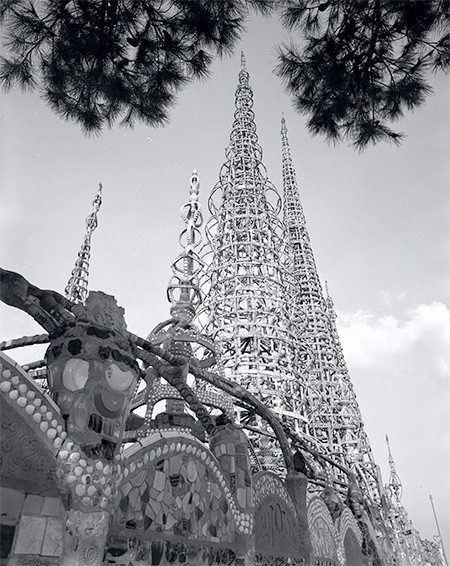In 1952 an article in the Los Angeles Times described how Sabato (Sam) Rodia (1879–1965), a working-class Italian immigrant with no formal training in art or architecture, worked for three decades to create a monument to his love for America. In an accompanying photograph Rodia poses at the base of his creation—three hundred-foot towers of steel covered in concrete and ornamented with intricate mosaics of shell, glass, and tile, surrounded by a playfully ornamented perimeter wall, graceful fountains, and numerous smaller tower forms. Rodia began to build these handmade structures in the 1920s, and for the first three decades of its existence his backyard environment had been little more than a local curiosity. This changed in the early 1950s, when the Los Angeles Times article was part of a wave of public attention directed at the unusual site, which came to be known as the Watts Towers after its location in the Watts neighborhood of Los Angeles. The label of “monument” was commonly applied to the Watts Towers, but the question of what exactly the site monumentalizes remains unresolved. Since the 1950s, the Watts Towers has had multiple meanings, standing as a marker of a humble immigrant’s achievement of the American dream, as an avant-garde work in the lineage of the German artist Kurt Schwitters or the Spanish architect Antonio Gaudí, and as a landmark of black cultural renaissance in the wake of violent uprising.
My dissertation is the first book-length academic study of the site. It traces how artists and other cultural workers in Los Angeles discovered and advocated for the Watts Towers from the 1950s through the 1970s and surveys the art and visual culture that emerged as a result—assemblage sculptures, black nationalist imagery, and museum exhibitions of self-taught art. Through these interactions artists made and remade the Watts Towers’ meaning as a public monument, and in turn, the site played a pivotal role in the formation of postwar cultural movements in California. By placing the Watts Towers at its center, my study revises the dominant narrative of modern art in Los Angeles, evaluating the works of well-known artists both in light of processes of urban renewal and in conversation with the visual cultures of social movements and community arts programs. Ultimately, I argue that artists’ appropriation of the Watts Towers worked to integrate racialized notions of folk art into the core of American modernism.
During my tenure as a Chester Dale Fellow I considered the crucial role that art and visual culture played in claiming the Watts Towers for a black public in the decade after the Watts Rebellion in August 1965. I analyzed the rich and understudied body of representations that incorporate the Watts Towers into the imagery of black nationalism alongside photographs of Muhammad Ali and fashion photo shoots with African textiles. I also conducted oral histories with artists like Judson Powell to understand how the minoritarian aesthetic of “junk” embodied in the towers resonated with the assemblage sculptures made by black artists that were shown in exhibitions such as 66 Signs of Neon. The integration of the Watts Towers into these new forms of cultural expression was key to its transformation from a structure whose location in a majority African American neighborhood seemed to be incidental to its meaning as a monument inextricable from that community. Further, in the context of the systematic cultural disenfranchisement of African Americans in Los Angeles, the reformulation of the meaning of the Watts Towers was a powerful strategy that mobilized representational counternarratives and new visions of black culture in the 1960s and 1970s.
I also devoted my time as a fellow to an examination of the ways in which the Watts Towers shaped the institutionalization of self-taught and folk art in the 1970s through curators and art historians from Los Angeles who moved into positions at institutions across the country, bringing their history with the Watts Towers with them. Among other examples, I identified a compelling comparison between these curators’ definitions of large-scale, self-taught art in two exhibitions, Naives and Visionaries (Walker Art Center, 1974) and In Celebration of Ourselves (San Francisco Museum of Modern Art, 1976). I presented this research at the National Gallery of Art as part of the symposium “Boundary Trouble: The Self-Taught Artist and American Avant-Gardes,” which took place in February 2018 in conjunction with the exhibition Outliers and American Vanguard Art. The generative conversations that emerged out of the symposium and the exhibition’s incisive historicization of the interactions between self-taught art and the mainstream continue to shape my thinking as I write a study of the Watts Towers that narrates a history of American modern and contemporary art from its margins.
